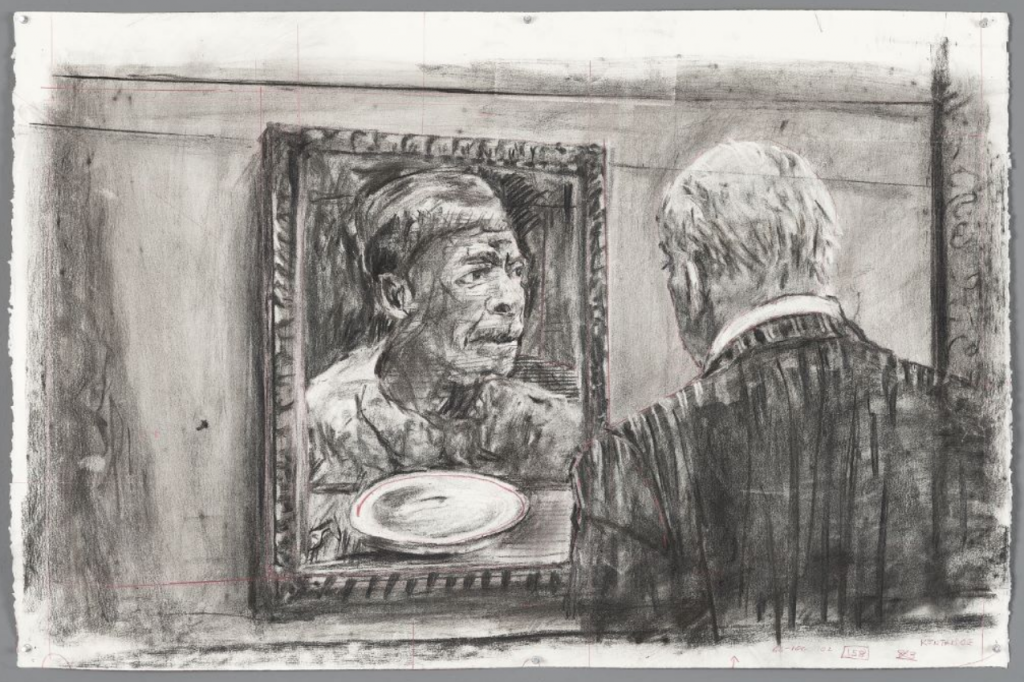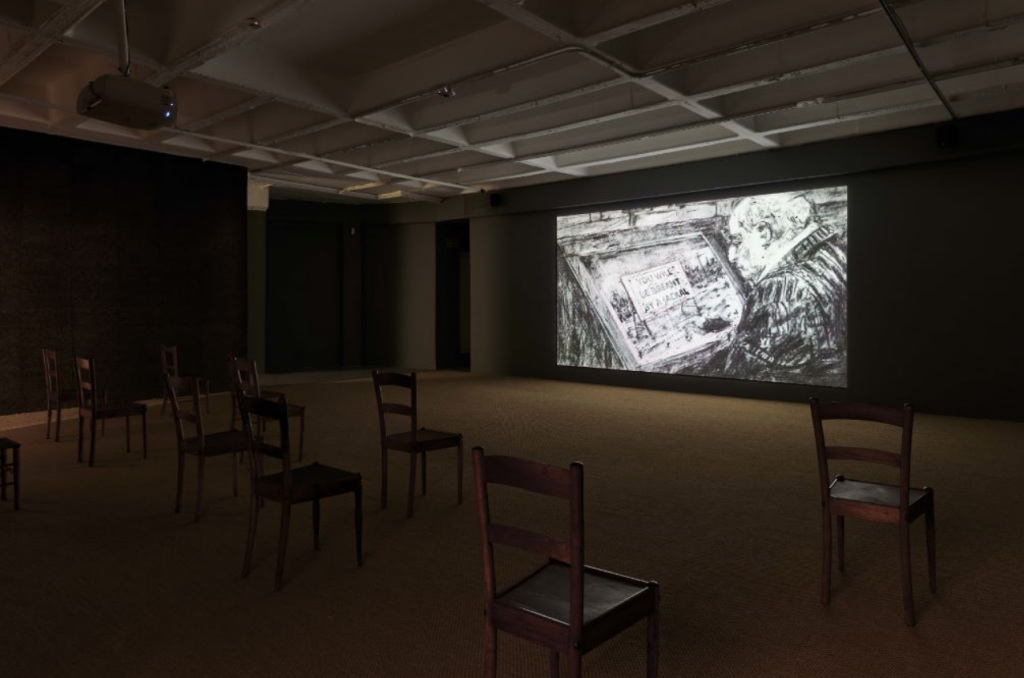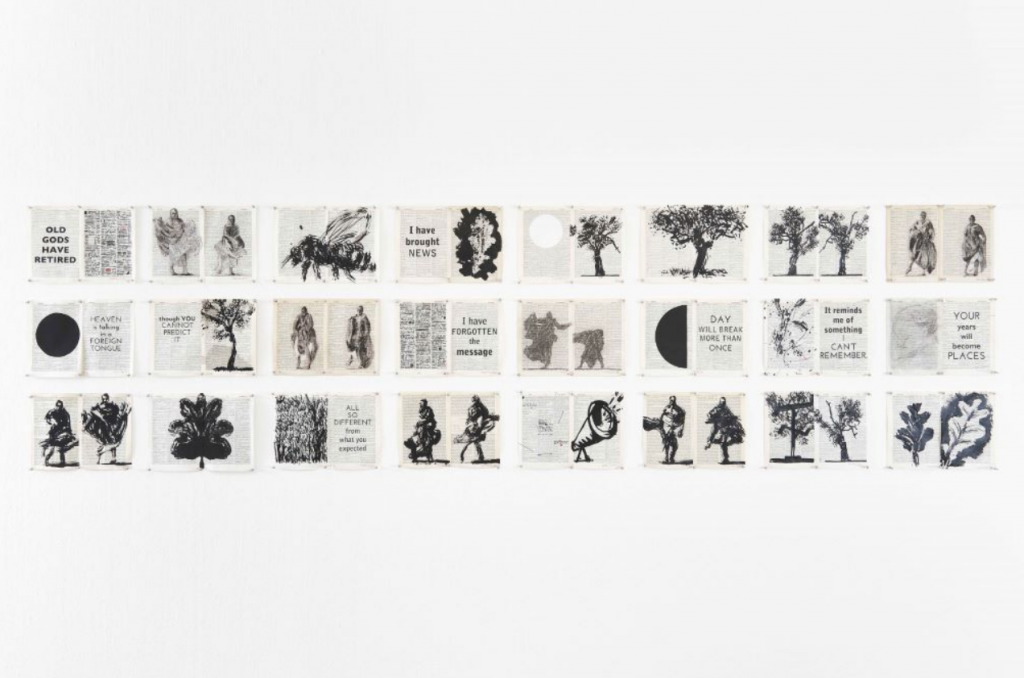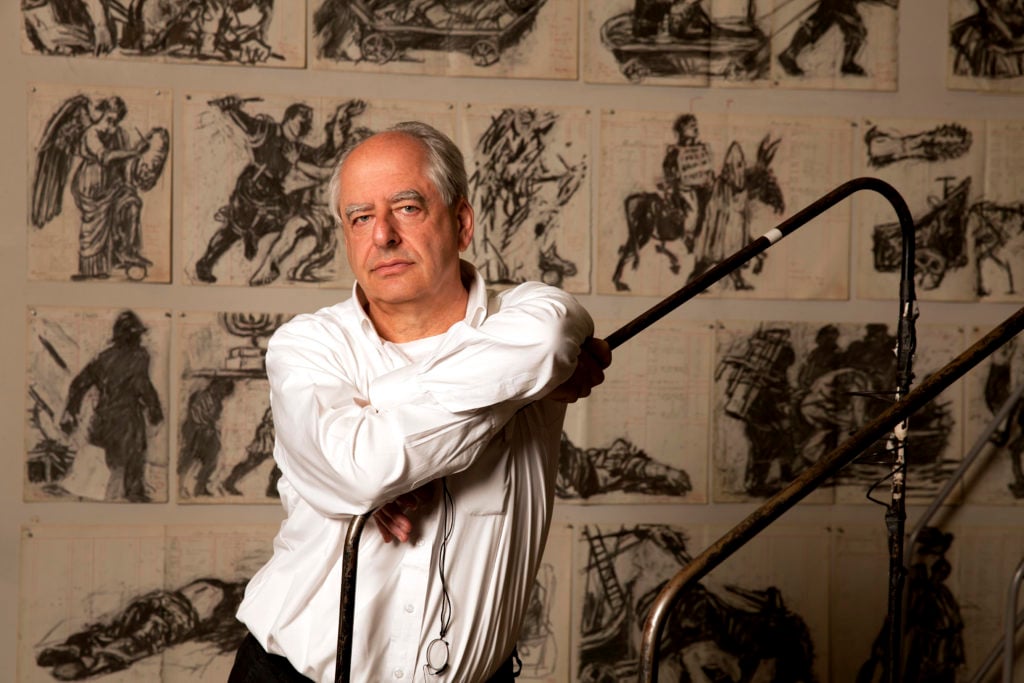Over the decades, through films, drawings, and operas, the celebrated South African artist William Kentridge has created a world that—while not quite our own—recognizably mirrors and shadows it.
This year, Kentridge debuted City Deep, the 11th film in the artist’s “Drawings for Projection” series, which began some 30 years ago. Rooted in his labor-intensive animation process of charcoal drawing, erasure, and redrawing, the film is the first in the series in over a decade, and recently debuted in “City Deep” at Goodman Gallery in Johannesburg (through November 12), alongside recent drawings and sculptures.
Since the beginning, these films have centered on three characters: Soho Eckstein, a rapacious mining tycoon; his wife, Mrs. Eckstein; and her lover, the daydreaming, humble artist Felix Teitlebaum. But in City Deep, Eckstein appears alone, wandering the Johannesburg Art Gallery, where he carefully observes artworks. On the walls and filling the vitrines are depictions of the Zama Zamas, contemporary illegal miners who scour old South African mines for remnants of gold. The gallery and the mine seem to zigzag together and apart until, in the film’s culmination, the gallery collapses in on itself.
On the occasion of the film’s debut, Kentridge spoke to Artnet News from the garden outside his studio in Johannesburg, where he’s been working through quarantine, about the complex character of Soho Eckstein, the development of informal economies, and his own bout with coronavirus.

William Kentridge, Drawing for City Deep (Soho Gazing at Portrait) (2019). Courtesy of Goodman Gallery.
Tell us about your new film, City Deep. Some people have noted that it draws on similar themes to those in your 1990–91 film Mine, which also brought us into the world of mining in Johannesburg. What’s changed in the roughly 30 years since that film was made?
City Deep was completed about a year ago but started four or five years ago. When Mine was made in the early 1990s, deep-level industrial mining with high-tech capital incentives was still a vital part of the South African economy. Mining is still important, but the number of miners employed by the former gold mines has dropped dramatically. This is allied with a generally increasing unemployment. Today, that means there are now many tens of thousands of artisan miners, who unofficially go into the areas where there were once gold mines, which have now closed or sometimes are still operating, and work on the surface, just with a hammer and chisel, breaking the rock in the hope of finding the last traces of gold. Or, in some cases, there are organized gangs, going down into unused mine shafts, and again, with the most minimal of tools, try to chip away at the rock, bring it to the surface, grind it between two pieces of concrete, pan it in an enamel bowl and through a sock, and mix it with mercury to try to leach out the last fragments of gold still left.
So in that sense, City Deep is a contrast to the film Mine, which was about the big mining industry. But City Deep is also about the importance of the informal economy as a support of the formal economy in South Africa. Without the informal economy, our society would collapse. Particularly with COVID now, it gives a means of sustenance to millions of people in the country.
This need for an informal economy to prop up the formal economy is not just a South African phenomenon, but it’s the premonition of what will happen in many places in the world [marked by] a gap between a formalized economy that works for a few, and the vast mass of people who will have to get by as best they can. Much more primitive technologies and means will be the pattern.
In the film, Eckstein wanders the Johannesburg Art Gallery, where Zama Zamas miners are depicted in artworks on the walls. What do you see as the connection between these two spaces of the mine and the gallery?
There’s always been a connection between mining and the Johannesburg Art Gallery, which was the art gallery of my childhood. It was funded and founded by mining magnates who made their fortunes from gold mining in South Africa and went back to live in London.
Lady Phillips, the wife of mining baron Lionel Phillips, warned that unless they made some contribution to this city, their names would live in infamy. So a number of collections of Dutch lace and oil paintings were given to the gallery, which now kind of molder there. And the gallery itself, in a difficult part of town, is in a state of terminal decline. That’s true physically of the building itself as well—the roof leaks, the beautiful Edwin Lutyens building is looking very shaky. The film is also about a demoralized institution, which gets no city support, and in which the staff themselves are demoralized as well. During the more than six months of COVID, the museum has made no effort to do anything online, to do anything at all.

Installation view “City Deep,” 2020. Courtesy of Goodman Gallery.
The character of Soho Eckstein has appeared in your films for decades. Has the character developed or changed across all that time? And how so?
He hasn’t really changed much. He’s a protagonist in as much as he’s the observer of different parts of history passing him by. He doesn’t really have agency; he’s watching the Zama Zamas, but he’s not building his own empire anymore or imploding it—whether he himself is the source of the implosion of the Johannesburg Art Gallery that occurs in the film is not really indicated.
Do you see yourself in Soho Eckstein?
Soho over the years has turned into a self-portrait in the third person. It’s not me, but I can’t pretend not to be connected to him either. And often I use myself as a model for him, so I suppose I am there in the films. There are other kinds of films in which I interrogate myself more directly, where I film myself twice in conversation. This is a big part of a series of films I’ve been making in lockdown called “Studio Life,” about what happens in the studio. A studio is a place both of making and of making meaning, a kind of metaphorically expanded head of thoughts.
In addition to the film, the exhibition includes drawings, which were made in preparation for your opera Waiting for the Sybil, which premiered in September 2019. Can you tell us about that opera and the drawings’ relationship to it? Any thoughts on the future of the theater?
Waiting for the Sybil is a chamber opera that was made for the Rome Opera a year ago. It was due to have been performed several times this year, but obviously those performances were canceled. Most have been reinstated in the next couple of years in the hope that live performance would be possible. With a vaccine, the theater will return as a fuller venue, I believe.
As for the opera, it doesn’t have a clear narrative but it takes as its central metaphor the Cumaean Sibyl outside of Naples. In the ancient world, you would go to visit the Sibyl and ask your fortune, your fate. She would write this down on an oak leaf and then you’d go to the mouth of her cave to collect your oak leaf with your fortune on it. But as you reached for the leaf, there’d always be a gust of wind and the leaves would swell about, so you never knew if you were getting your fate or somebody else’s. Well, that’s the basis of the ambiguity of our desire for knowledge of our own fortune and fate. The other transposition of the drawings is taking the idea of a leaf of a tree as the leaf of a book. I think 1,500 drawings were made on different pages of books.
You mentioned a new series of films about the studio. How has quarantine affected your practice?
In June, with the high point of the pandemic in South Africa, 13 of us in the studio or connected to the studio contracted coronavirus, but all recovered, including myself. Now the studio is almost a “corona-safe” zone. Quarantine has been paradoxical, then.
I do a lot of work in performance with dancers, actors, musicians, and for almost all of them, it has been a calamitous loss of eight or nine months. Not only has there been no income because performances haven’t taken place, but there’s not been the possibility of performing their craft, of practicing their metiers. Dancers haven’t been dancing, musicians haven’t been playing, actors have been in their own houses. For them both financially and psychically, it’s been a very traumatic time. I have the good fortune of having a studio in my garden and for me, the lockdown has instead been fantastic.
I’ve had eight months in my studio without having to travel, without having to go to an exhibition opening, and without any of the disturbances that usually fill the air. During this time I’ve been working very specifically on “The Studio Project.” What happens in the studio and what are the kinds of thoughts and associations that arise from it? And this is a project that will take another year and a half at least to finish, to make a series of 12 films, but it’s had a very good start.

Installation view of “City Deep,” 2020. Courtesy of Goodman Gallery.
Your work often involves sociopolitical aspects, which makes me wonder, especially now: Do you watch the news?
Yes, I admit I’ve become kind of obsessed with the numbers. So every day, a couple of times a day, I check through all the COVID numbers of every country in the world scene—to see who’s doing what, how different countries are doing, how we’re doing here in South Africa. I think everybody’s turned into a kind of amateur statistician, so I’m certainly guilty of that crime as well. I do read the news. It’s hard not to follow it either on television or the phone but more than that I just obsessively look at the numbers.
And then at three in the morning, I do the math: say my studio is six meters high and I lodged the ceiling to, say, seven and a half meters of height, and called that the population of the world. Then if I drew a thin line with a red pencil where the floor meets the wall, that would be the number of people who have died of COVID, compared to the seven and a half meters of height of the studio. So that’s a kind of stupid exercise I go through in the middle of the night.
You’ve been in the studio devotedly for many months. What would you say is your favorite tool in your studio right now?
I have beautifully made sticks of charcoal as thick as your wrist, and which are intensely black. There’s an extraordinary sensuality when that piece of burnt wood meets a good piece of paper. So that, I suppose, is the heart of what happens in the studio.
Follow Artnet News on Facebook:
Want to stay ahead of the art world? Subscribe to our newsletter to get the breaking news, eye-opening interviews, and incisive critical takes that drive the conversation forward.








